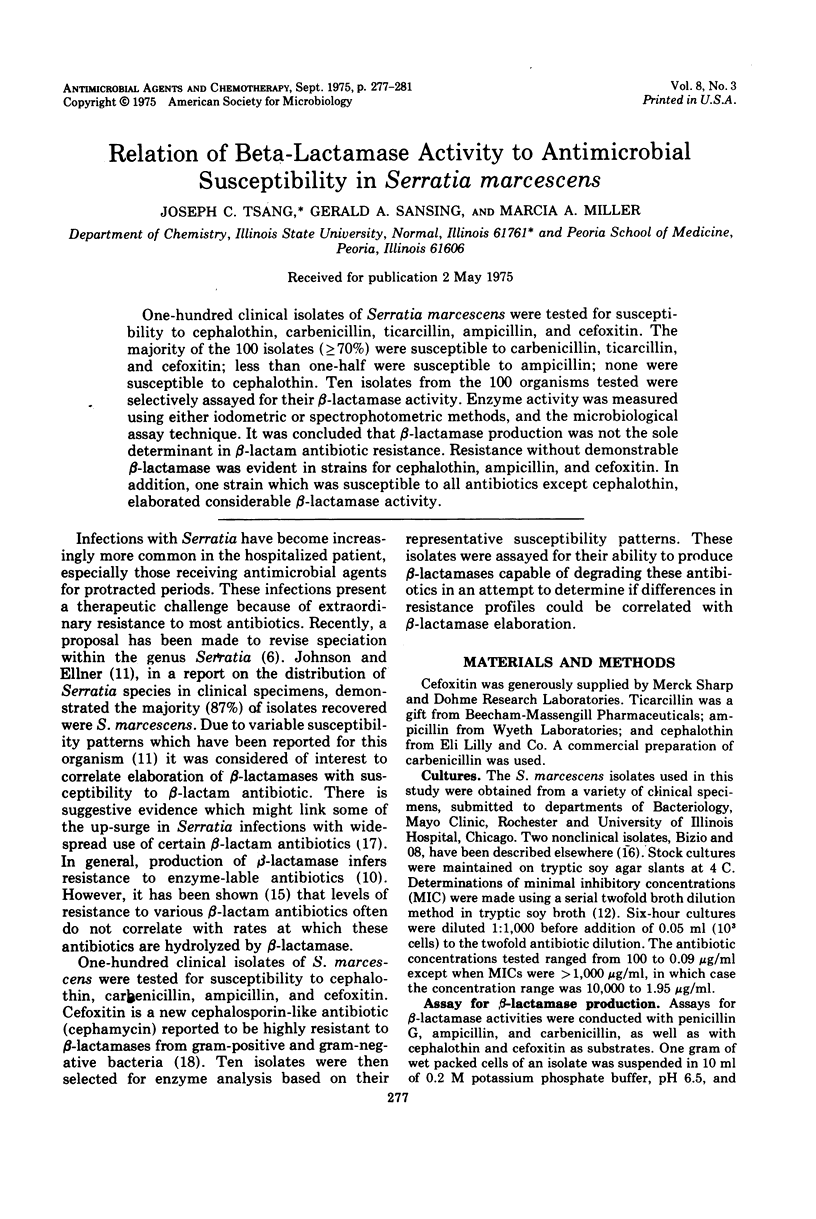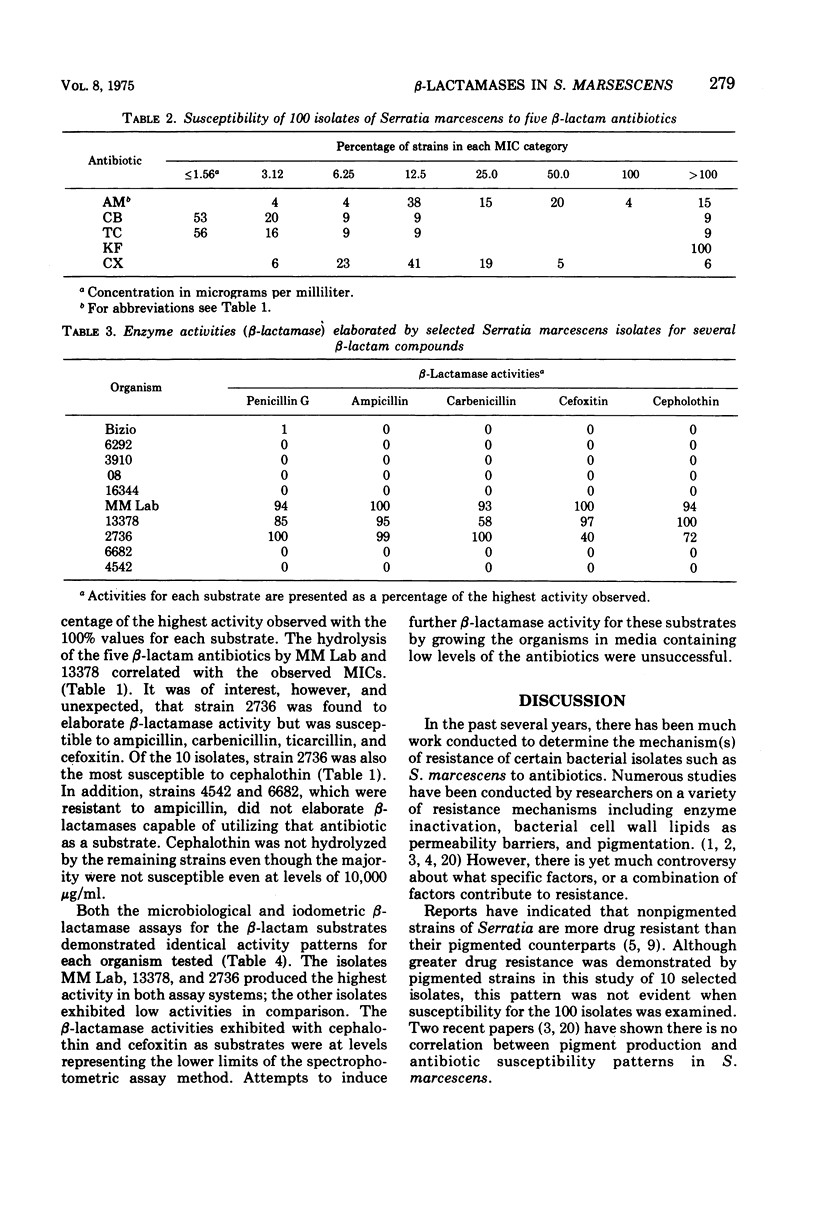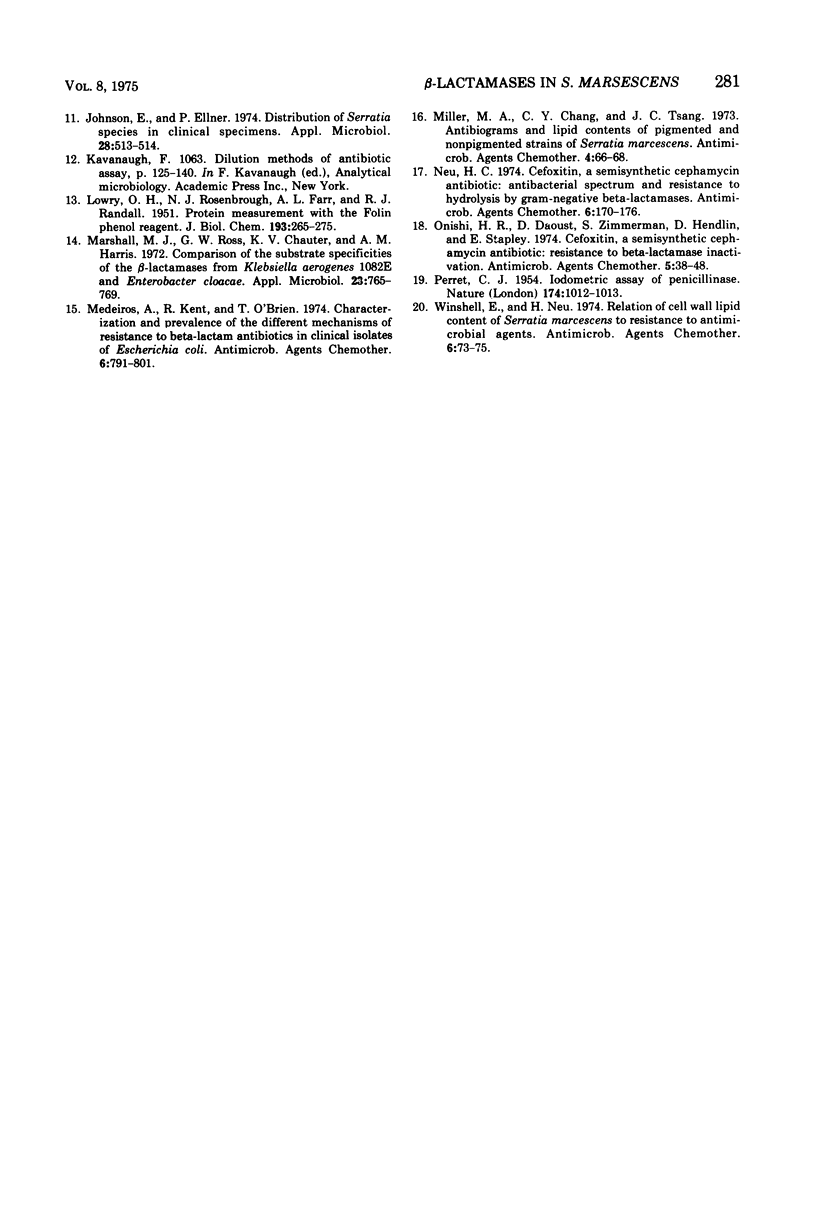Abstract
One-hundred clinical isolates of Serratia marcescens were tested for susceptibility to cephalothin, carbenicillin, ticarcillin, ampicillin, and cefoxitin. The majority of the 100 isolates (≥70%) were susceptible to carbenicillin, ticarcillin, and cefoxitin; less than one-half were susceptible to ampicillin; none were susceptible to cephalothin. Ten isolates from the 100 organisms tested were selectively assayed for their β-lactamase activity. Enzyme activity was measured using either iodometric or spectrophotometric methods, and the microbiological assay technique. It was concluded that β-lactamase production was not the sole determinant in β-lactam antibiotic resistance. Resistance without demonstrable β-lactamase was evident in strains for cephalothin, ampicillin, and cefoxitin. In addition, one strain which was susceptible to all antibiotics except cephalothin, elaborated considerable β-lactamase activity.
Full text
PDF




Selected References
These references are in PubMed. This may not be the complete list of references from this article.
- Anderes E. A., Sandine W. E., Elliker P. R. Lipids of antibiotic-sensitive and -resistant strains of Pseudomonas aeruginosa. Can J Microbiol. 1971 Nov;17(11):1357–1365. doi: 10.1139/m71-217. [DOI] [PubMed] [Google Scholar]
- Brown M. R., Watkins W. M. Low magnesium and phospholipid content of cell wals of Pseudomonas aeruginosa resistant to polymyxin. Nature. 1970 Sep 26;227(5265):1360–1361. doi: 10.1038/2271360a0. [DOI] [PubMed] [Google Scholar]
- Button G. L., Miller M. A., Tsang J. C. Antibiogram and lipid analysis of a pigmented strain of Serratia marcescens and its nonpigmented variants. Antimicrob Agents Chemother. 1975 Feb;7(2):219–222. doi: 10.1128/aac.7.2.219. [DOI] [PMC free article] [PubMed] [Google Scholar]
- Chang C. Y., Molar R. E., Tsang J. C. Lipid content of antibiotic-resistant and -sensitive strains of Serratia marcescens. Appl Microbiol. 1972 Dec;24(6):972–976. doi: 10.1128/am.24.6.972-976.1972. [DOI] [PMC free article] [PubMed] [Google Scholar]
- Clayton E., Von Graevenitz A. Nonpigmented Serratia marcescens. JAMA. 1966 Sep 26;197(13):1059–1064. [PubMed] [Google Scholar]
- Farrar W. E., Krause J. M. Relationship Between beta-Lactamase Activity and Resistance of Enterobacter to Cephalothin. Infect Immun. 1970 Nov;2(5):610–616. doi: 10.1128/iai.2.5.610-616.1970. [DOI] [PMC free article] [PubMed] [Google Scholar]
- Garber N., Friedman J. Beta-lactamase and the resistance of Pseudomonas aeruginosa to various penicillins and cephalosporins. J Gen Microbiol. 1970 Dec;64(3):343–352. doi: 10.1099/00221287-64-3-343. [DOI] [PubMed] [Google Scholar]
- Grimont P. A., Dulong de Rosnay H. L. Numerical study of 60 strains of Serratia. J Gen Microbiol. 1972 Sep;72(2):259–268. doi: 10.1099/00221287-72-2-259. [DOI] [PubMed] [Google Scholar]
- Jackson G. G., Lolans V. T., Gallegos B. G. Comparative activity of bacterial beta-lactamases on penicillins and cephalosporins. J Infect Dis. 1973 Oct;128(Suppl):S327–S323. doi: 10.1093/infdis/128.supplement_2.s327. [DOI] [PubMed] [Google Scholar]
- Johnson E., Ellner P. D. Distribution of Serratia species in clinical specimens. Appl Microbiol. 1974 Sep;28(3):513–514. doi: 10.1128/am.28.3.513-514.1974. [DOI] [PMC free article] [PubMed] [Google Scholar]
- LOWRY O. H., ROSEBROUGH N. J., FARR A. L., RANDALL R. J. Protein measurement with the Folin phenol reagent. J Biol Chem. 1951 Nov;193(1):265–275. [PubMed] [Google Scholar]
- Marshall M. J., Ross G. W., Chanter K. V., Harris A. M. Comparison of the substrate specificities of the -lactamases from Klebsiella aerogenes 1082E and Enterobacter cloacae P99. Appl Microbiol. 1972 Apr;23(4):765–769. doi: 10.1128/am.23.4.765-769.1972. [DOI] [PMC free article] [PubMed] [Google Scholar]
- Medeiros A. A., Kent R. L., O'Brien T. F. Characterization and prevalence of the different mechanisms of resistance to beta-lactam antibiotics in clinical isolates of Escherichia coli. Antimicrob Agents Chemother. 1974 Dec;6(6):791–801. doi: 10.1128/aac.6.6.791. [DOI] [PMC free article] [PubMed] [Google Scholar]
- Miller M. A., Chang C. Y., Tsang J. C. Antibiograms and lipid contents of pigmented and nonpigmented strains of Serratia marcescens. Antimicrob Agents Chemother. 1973 Jul;4(1):66–68. doi: 10.1128/aac.4.1.66. [DOI] [PMC free article] [PubMed] [Google Scholar]
- Neu H. C. Cefoxitin, a semisynthetic cephamycin antibiotic: antibacterial spectrum and resistance to hydrolysis by gram-negative beta-lactamases. Antimicrob Agents Chemother. 1974 Aug;6(2):170–176. doi: 10.1128/aac.6.2.170. [DOI] [PMC free article] [PubMed] [Google Scholar]
- Onishi H. R., Daoust D. R., Zimmerman S. B., Hendlin D., Stapley E. O. Cefoxitin, a semisynthetic cephamycin antibiotic: resistance to beta-lactamase inactivation. Antimicrob Agents Chemother. 1974 Jan;5(1):38–48. doi: 10.1128/aac.5.1.38. [DOI] [PMC free article] [PubMed] [Google Scholar]
- PERRET C. J. Iodometric assay of penicillinase. Nature. 1954 Nov 27;174(4439):1012–1013. doi: 10.1038/1741012a0. [DOI] [PubMed] [Google Scholar]
- Winshell E. B., Neu H. C. Relation of cell wall lipid content of Serratia marcescens to resistance to antimicrobial agents. Antimicrob Agents Chemother. 1974 Jul;6(1):73–75. doi: 10.1128/aac.6.1.73. [DOI] [PMC free article] [PubMed] [Google Scholar]


